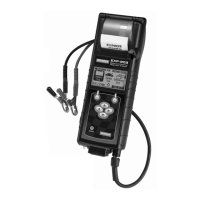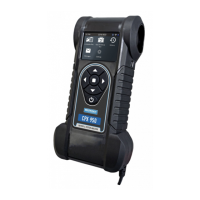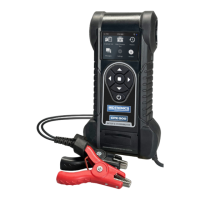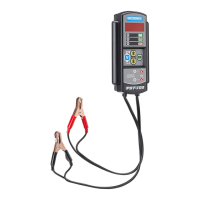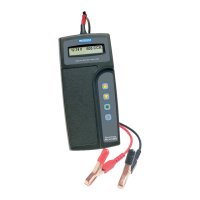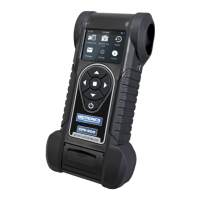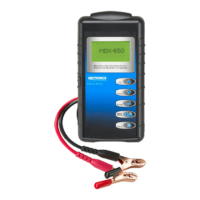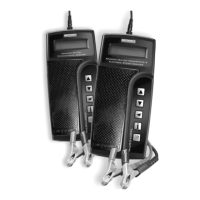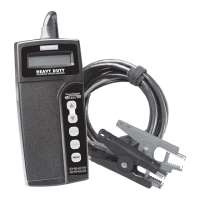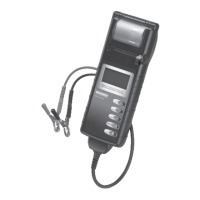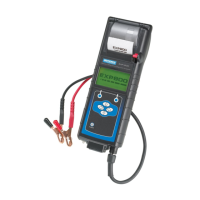
Do you have a question about the Midtronics EXP-800 and is the answer not in the manual?
| Operating Temperature | 0°C to 50°C (32°F to 122°F) |
|---|---|
| Languages | Multiple Languages Supported |
| Storage Temperature | -20°C to 70°C (-4°F to 158°F) |
| Charging System Test | Yes |
| Starter Test | Yes |
| Alternator Test | Yes |
| Battery Types Supported | Flooded, AGM, GEL, EFB |
| Measurement Capabilities | Battery test, Charging system test, Starter test |
| Connectivity | USB |
| Voltage Range | 1.5V to 30V DC |
| Test Range | 100 to 2200 CCA |
| Battery Test Voltage Range | 1.5V to 30V DC |
| Battery Test Technology | Conductance Technology |
| Data Storage | Yes, stores test results |
| Type | Battery and Electrical System Analyzer |
| Display | 2.8" color display |
| Printer Compatibility | Compatible with external printers via connectivity options |
Review safety and operating instructions before using the analyzer, following manufacturer and BCI recommendations.
Essential safety measures for working with batteries, including eye protection, avoiding sparks, and handling acid.
Identifies and describes the analyzer's external connections, including ports for data cards and test cables.
Instructions for properly connecting the battery test cable and handling the data card slot.
Details the analyzer's LCD screen elements and keypad functions for navigation and operation.
Explanation of the scroll bar and arrow keys used for navigating through menus and lists.
Describes various methods for entering data, including menu icons, option buttons, scrolling lists, and alphanumeric entry.
Graphical representation of the menu structure, detailing the Main Menu and Info Menu utilities.
Overview of utilities for customizing analyzer settings, managing users, and administrative functions.
Guide for first-time login, language selection, and entering store ID and zip code.
Instructions for logging in as an unregistered user, adding new users, and disabling login screens.
Settings for clock, date, format, display contrast, backlight, and temperature units.
Utilities for setting up shop info, creating, editing, and deleting user IDs.
Controls for user login, printer headers, admin PIN, and screen input options.
Adjusting the analyzer's time, date format, and clock mode (12/24 hour).
Creating or overwriting a header for printed test results with business location information.
Creating, editing, and deleting user IDs for test tracking and access control.
Details on deleting placeholder user IDs and managing existing user entries.
Adjusting the LCD screen contrast level and backlight time for optimal viewing.
Enabling or disabling custom coupons or messages on printed test results.
Creating and storing promotional coupons or messages for printed test results.
Selecting preferred units for temperature measurements (Fahrenheit or Celsius).
Enabling or disabling the storage of test results and codes in an .xml file on the data card.
Selecting display language and configuring administrative options like user login and print headers.
Entering or changing the store ID number that appears on printed test results.
Procedures for formatting a data card to receive data and updating analyzer software.
Visual inspection checklist for batteries, including case, connections, and electrolyte levels.
Specific safety and handling procedures for testing batteries removed from a vehicle.
Preparation steps for testing the vehicle's starting and charging systems while the battery is connected.
Correctly connecting the analyzer's clamps to the battery terminals for accurate testing.
Step-by-step guide for conducting a battery test, including selecting parameters and entering data.
Explanation of messages like 'System Noise Detected' and 'Unstable Battery Detected' during testing.
Understanding the analyzer's output, including test codes, voltage, and State of Health (SOH).
Definition and significance of the battery's State of Health (SOH) in assessing its condition.
Explanation of the different battery test decisions and recommended actions (e.g., Good Battery, Replace).
Procedure for testing the vehicle's starter system, including engine cranking and voltage analysis.
Procedure for testing the vehicle's charging system, including alternator output and diode ripple.
Interpreting the analyzer's decisions for charging system performance (e.g., No Output, High Output).
Understanding diode test results, such as Excessive Ripple, Open Phase, or Shorted Diode.
Steps for conducting a PDI (Preventative Diagnostic Inspection) test on inventory batteries.
Options for printing individual or summary results for PDI battery tests.
Viewing and printing results from previous Battery and System Tests.
Reviewing total tests performed, data transfer utility, and analyzer version information.
Instructions for printing a second copy of test results and selecting the language.
Step-by-step guide on how to replace the thermal paper roll in the internal printer.
Solutions for display issues such as not turning on, flickering, or dimness.
Troubleshooting steps for when the internal printer fails to print.
Guidelines for cleaning clamps, storing cables, and handling them to prevent damage and wear.
Procedure for testing the continuity and resistance of the battery test cables.
Explanation of the battery power indicator on the display and when batteries need replacing.
Step-by-step instructions for safely removing and replacing the analyzer's internal AA batteries.
